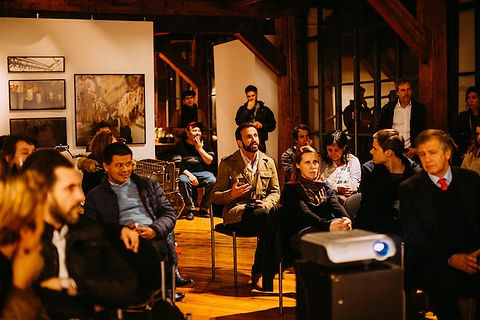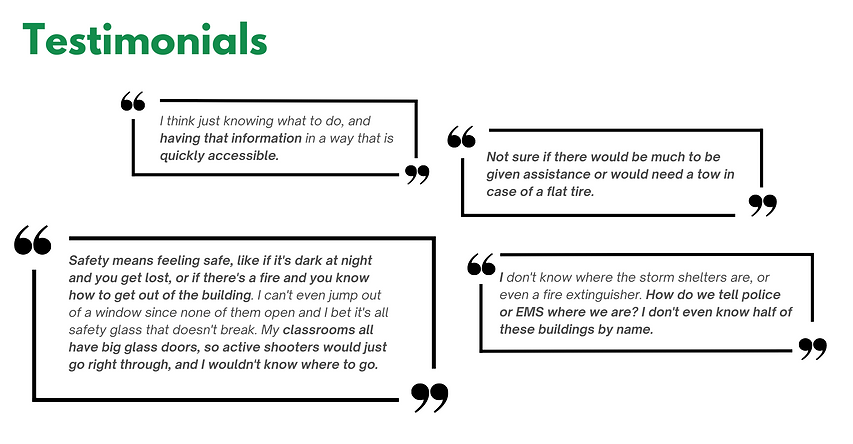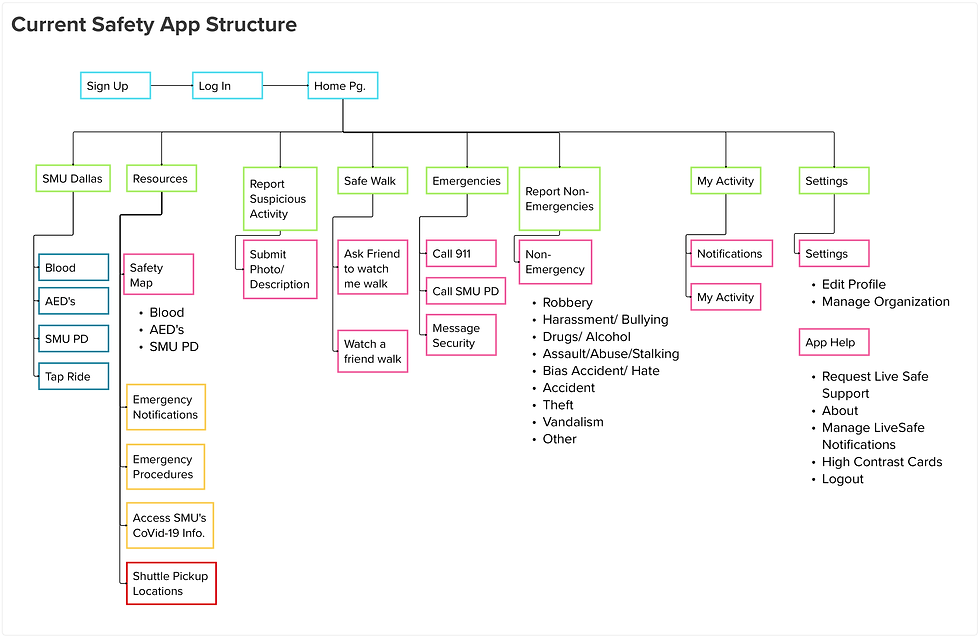
The SMU Safety Hub
The SMU Aware team specializes in campus safety communications and responses, they serve a campus of +12k students and +1600 full time faculty/staff. The SMU Aware team implemented all recommendations that we provided for public safety communications, app services, alongside health and wellness related safety services for the entire campus.
As a college campus there are many concerns about the student wellbeing with gun safety, health hazards, and more. The probability of becoming a victim of a violent crime is 1 in 220 for the state, when referencing the residents of Highland Village, this includes the students and faculty/staff within the SMU campus.
A nationwide survey studying students' perception of safety on campus showed that they felt safer with an anonymous tip line or web application to deter behavior.
- According to the Gun Violence archive (2019), within the first 3 weeks of 2019, nine mass shootings took place, including one at at an elementary school and one at a middle school.
- For the period 2017-2021, active shooter incident data reveals an upward trend: the number of active shooter incidents identified in 2021 represents a 52.5% increase from 2020 and a 96.8% increase from 2017.
Roles
- Human-Centered Design Researcher
- Service Designer
Responsibilities
- Senior Design Lead
- User Researcher
Time
- 12 Weeks / 4 Months
Industry
- Design
- Public Safety & Services
- Higher Education
Partners
- University Students
- SMU Aware Staff
Design Challenge Definition:
Our research began with public and private university safety standards/protocols, to provide us with a baseline of expectations, goals, and next steps for the SMU Aware team. We consistently refined our process via student validation, protocols, lived experiences with university safety standards, and other datapoints to give us a wicked design challenge. We focused on the following topics in the university safety research at SMU.

Peer Resources & Services
- What website & app features are easily accessed, up to date, and understandable to potential users?

How other universities of the same size and demographic/classification, manage and communicate campus safety.
Student perceptions of safety services & resources across the SMU campus via campus alerts, texting notifications and website communications.
Quality and consistency of communication management and information across the SMU Aware network of services/publications.
Student Interviews
- What are the lived student experiences with SMU Aware and their safety resources/ platforms?
Safety Platforms
- What student/faculty trainings are offered in-person, online, and who has access to these?
When we considered our initial meeting with the SMU Aware team, they led us to their mobile app, the websites consisted of many sparse messages but overall the consistent key component was the SMU Aware safety app. We noticed a key push to the mobile platform and the website for all safety communications, alerts, and updates.
Feature Based Comparison
.png)
The push to the Live Safe app had us compare 17 public and private universities of the same size/ demographic/ classification which provided some form of mobile safety apps. 6 developed their own application, and 8 used the Live Safe competitors as mobile application providers.
When we looked at the results we were missing some key components in safety. The people of SMU, their understanding, and perceptions of effectiveness in communications.
Understand:
We developed a primary convenience study on a total of nine students of the SMU campus to gauge the overall student body and their experiences with campus safety.
This initial research consisted of a 9 question survey in student safety awareness, and indexes of the services which were communicated the most on campus/ online.
The survey was delivered to 9 students, 3 Male and 6 Female within a 22-30 age range, all commuter students at SMU.
We came out of the primary survey area with four initial student outcomes to lead us in our human centered design process.
- Safety Training Sessions
- Lighting on Campus
- SMU Alerts
- SMU LiveSafe App
Based on the interview, our team came to the conclusion that commuter students believe that the SMU Aware LiveSafe has the most potential to better provide a hub for safety resources that serve students.
The rest of our process was developed with the following statement in mind:
Designing for the extreme
We focused on the graduate commuter students
- Most live off-campus.
- Graduate students make up 44% of the student body.
- Many are employed off-campus and commute to SMU during non-traditional hours.
- The average age is 10 years older than undergraduates, closer to faculty/staff.

We believed that we could help SMU Aware better serve the SMU community by identifying features that would reframe the mobile safety app - instead of the website - as the hub for SMU Aware. This belief led us to conduct a new survey specifically for graduate students.
Refine:
Our secondary survey was a 12 question gauge in measures of student success, perceptions of safety, and indexes of the services communicated the most on campus or online by the SMU Aware Team.
We decided to continue investigations with these four safety points (Safety Training Sessions, Lighting on Campus, SMU Alerts - SMU LiveSafe App) in mind via another interview round to determine the wants and needs of the SMU graduate commuter students.
8 in-state 2 Out-of-state 2 international 9 working students, 2 were parents/guardians.
A total of 12 graduate commuter students who participated in our interview.
The result was an outstanding 213 insights/ ideas about the app's current and future services, features, and communications.

Some of the key student statements:

Ideation/imagine:
If the hub contains resources that graduate commuter students tell us they want, would those people find enough value in them to download and use that app?
What would need to be true for the graduate commuter students at SMU to download and regularly use the SMU Live Safe app as their safety hub for resources and alerts?
We decided to continue with the following four key insights from our student surveys, to determine the wants and needs of the graduate commuter students who are visiting, attending, or living in SMU.
We believe that the graduate commuters would be more likely to download and use the hub if its features support both:
Routine needs
Severe Weather & Safety Alerts
Commute Planning & Interactive Maps
Students want aids to help plan their commute to campus while knowing the safest and quickest way to campus
Students want to have accurate alert, messaging, and push notifications for safety & severe weather alerts
Emergency Needs
Counseling Services
Resources & Emergency Protocols
Students want to book, call, or navigate mental health resources within the app
Students need to know who they can rely on and what to do in an emergency. They want a one-stop shop that is easy to access.
Make:
We would then need to complete a final validation with the student body by comparing the current safety app structure to the proposed app restructure.




The final round of interviews tested whether our redesigned app structure met the needs of our audience.
We interviewed 9 people similar in profile to those from our previous interviews.
We asked them to redesign the current app structure based on the 4 key insights and all the parts of the proposed structure.
We showed them our proposed app structure, and asked them to add any elements that were missing from what they would want in the app.
.png)